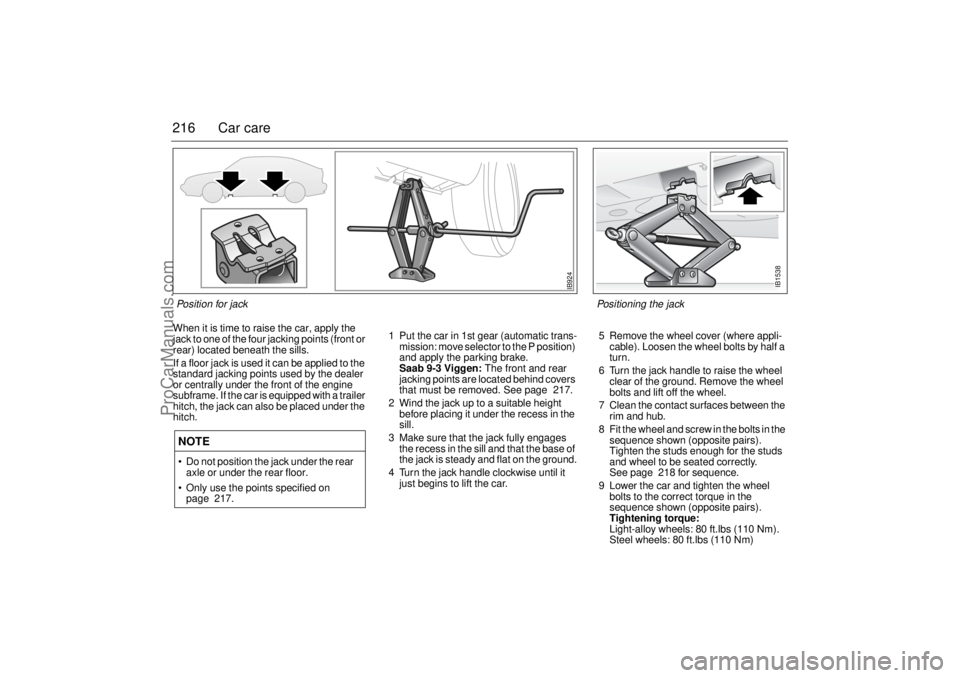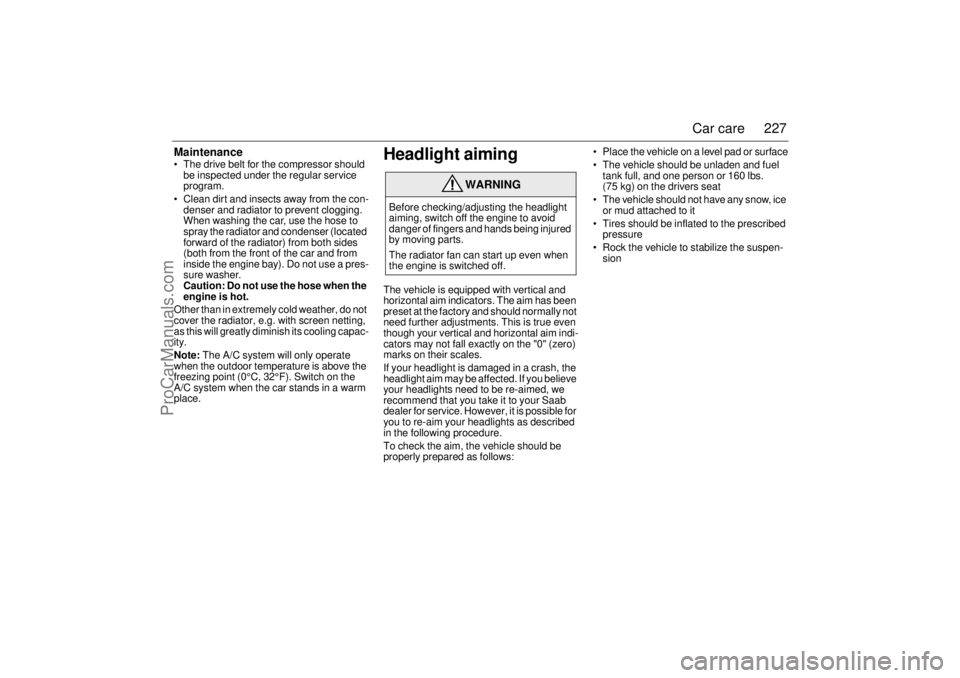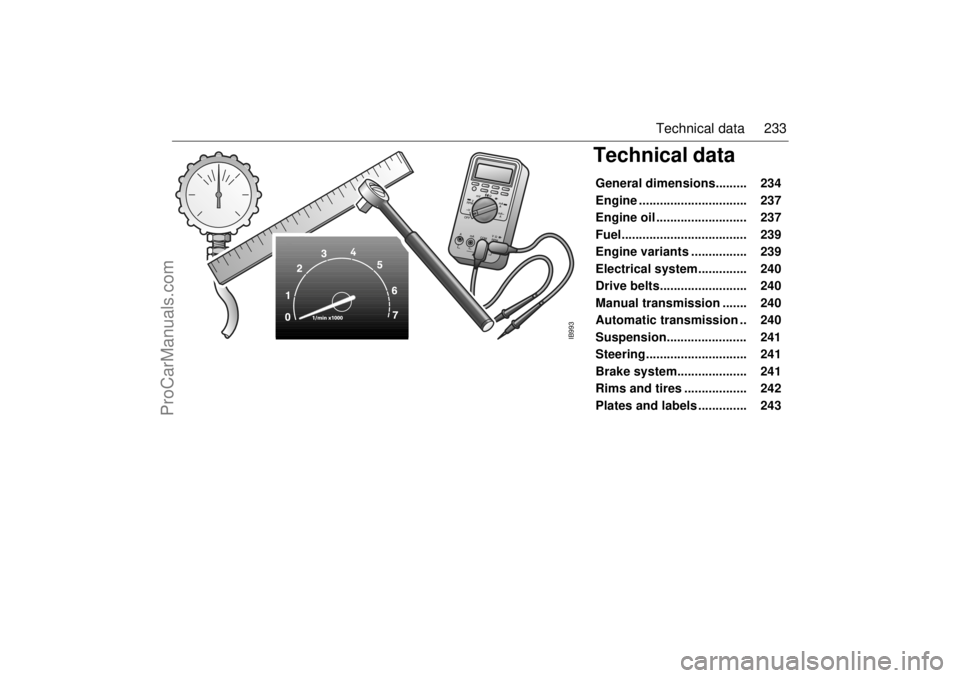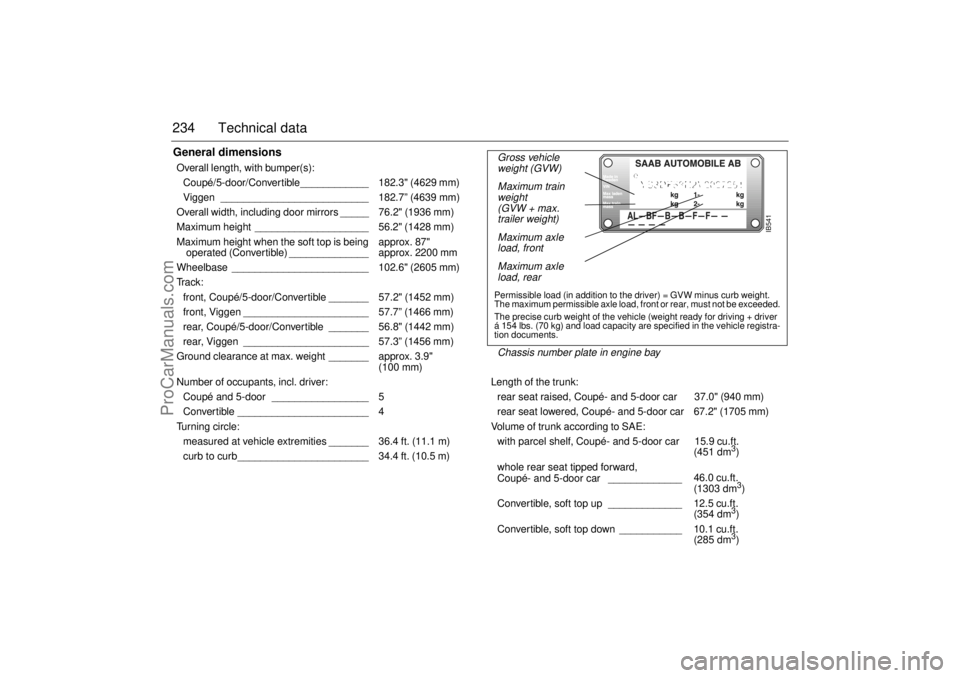Engine SAAB 9-3 2002 Manual Online
[x] Cancel search | Manufacturer: SAAB, Model Year: 2002, Model line: 9-3, Model: SAAB 9-3 2002Pages: 256, PDF Size: 11.55 MB
Page 216 of 256

216 Car careWhen it is time to raise the car, apply the
jack to one of the four jacking points (front or
rear) located beneath the sills.
If a floor jack is used it can be applied to the
standard jacking points used by the dealer
or centrally under the front of the engine
subframe. If the car is equipped with a trailer
hitch, the jack can also be placed under the
hitch. 1 Put the car in 1st gear (automatic trans-
mission: move selector to the P position)
and apply the parking brake.
Saab 9-3 Viggen: The front and rear
jacking points are located behind covers
that must be removed. See page 217.
2 Wind the jack up to a suitable height
before placing it under the recess in the
sill.
3 Make sure that the jack fully engages
the recess in the sill and that the base of
the jack is steady and flat on the ground.
4 Turn the jack handle clockwise until it
just begins to lift the car. 5 Remove the wheel cover (where appli-
cable). Loosen the wheel bolts by half a
turn.
6 Turn the jack handle to raise the wheel
clear of the ground. Remove the wheel
bolts and lift off the wheel.
7 Clean the contact surfaces between the
rim and hub.
8 Fit the wheel and screw in the bolts in the
sequence shown (opposite pairs).
Tighten the studs enough for the studs
and wheel to be seated correctly.
See page 218 for sequence.
9 Lower the car and tighten the wheel
bolts to the correct torque in the
sequence shown (opposite pairs).
Tightening torque:
Light-alloy wheels: 80 ft.lbs (110 Nm).
Steel wheels: 80 ft.lbs (110 Nm)NOTE Do not position the jack under the rear
axle or under the rear floor.
Only use the points specified on
page 217.
IB924
Pos i ti o n for j ack
IB1538
Positioning the jack
ProCarManuals.com
Page 220 of 256

220 Car careEngine bayClean the engine compartment using an
engine detergent and rinse with hot water.
Cover the headlights. Do not use a
high-pressure washer
Avoid spraying the hood liner, as this can
become heavy and hang down and touch
the engine when the hood is closed.
Do not use gasoline as a cleaning agent or
solvent when carrying out repairs or mainte-
nance. Saab recommends the use of envi-
ronmentally safe degreasing agents.
WashingThe bodywork must be washed frequently.
When the car is new, the body should be
washed by hand using plain cold water and
a clean, soft brush, or in a brushless car-
wash that uses mild detergent. Automatic
carwashes with brushes should be avoided
when the car is new. Do not use automatic
car washes for the first five or six months,
before the paintwork has hardened prop-
erly. Thereafter, use a high quality car wash
soap added to lukewarm water.
Do not use a pressure washer at close
range on stone chip damage, scratches or
other damage to the paintwork. The paint
can otherwise start to flake.
Remove any bird droppings without delay,
as these can discolor the paintwork and
prove difficult to polish out.
Use a soft cloth moistened with methyl alco-
hol to remove splashes of tar or asphalt. Do
not use strong cleaners, as these can dry
out the paintwork. The underside of the car also needs wash-
ing regularly, and this should be done very
thoroughly at the end of winter. Clean the
underside of the car by hand if the car is usu-
ally washed in an automatic car wash with-
out special facilities for underbody cleaning.
Never wash or leave the car to dry in the
sun, but wipe it dry with a chamois leather
immediately after washing to avoid smears
and streaks.
Clean the window glass inside and out using
a high quality window cleaner. This is partic-
ularly important when the car is new, as
upholstery and trim have a tendency to
sweat a little at first.
Keep the glass well cleaned, as this helps to
prevent misting.NOTEAvoid using any alcohol-based cleaners
on the front and rear light clusters, as
these can cause cracking of the lenses.
ProCarManuals.com
Page 224 of 256

224 Car careInspect the undercoating and touch up if
necessary. Pay particular attention to the
fenders and wheel housings, which are
exposed to abrasion by flying gravel, etc. If
the composition has worn or flaked off, the
steel must be thoroughly cleaned and dried
before a fresh coat is applied. The cleaning
is best done with a scraper and a steel wire
brush, followed by washing with solvent.
Apply the new coating thinly, otherwise it
may run off or fall off when dry.
Recovery and/or
recycling of automotive
materialsA typical car consists of metals (65–75%),
plastics (10–15%), rubber (5%) and small
quantities of glass, wood, paper and tex-
tiles.
Some of these materials can be recycled,
while others can be recovered in chemical
processes for reuse in new products or as a
source of energy.
While the Saab 9-3 was still at the draw-
ing-board stage, Saab engineers were
giving serious consideration to how the
maximum quantity of materials could be
reclaimed from the car on its eventual
scrapping. To facilitate sorting, plastic parts,
for instance, have been marked to identify
the precise nature of the plastic.Approximately 90% of the materials in the
car can be recycled or recovered, where
facilities exist.
Before the car is scrapped, all the oils and
other fluids that could pollute the environ-
ment should be recovered from the car. It
may be of interest in this context to learn that
the refrigerant used in the Saab 9-3’s A/C
and ACC systems (R134a) contains neither
CFCs nor any other chlorine compounds
ProCarManuals.com
Page 227 of 256

227 Car care
Maintenance The drive belt for the compressor should
be inspected under the regular service
program.
Clean dirt and insects away from the con-
denser and radiator to prevent clogging.
When washing the car, use the hose to
spray the radiator and condenser (located
forward of the radiator) from both sides
(both from the front of the car and from
inside the engine bay). Do not use a pres-
sure washer.
Caution: Do not use the hose when the
engine is hot.
Other than in extremely cold weather, do not
cover the radiator, e.g. with screen netting,
as this will greatly diminish its cooling capac-
ity.
Note: The A/C system will only operate
when the outdoor temperature is above the
freezing point (0°C, 32°F). Switch on the
A/C system when the car stands in a warm
place.
Headlight aimingThe vehicle is equipped with vertical and
horizontal aim indicators. The aim has been
preset at the factory and should normally not
need further adjustments. This is true even
though your vertical and horizontal aim indi-
cators may not fall exactly on the "0" (zero)
marks on their scales.
If your headlight is damaged in a crash, the
headlight aim may be affected. If you believe
your headlights need to be re-aimed, we
recommend that you take it to your Saab
dealer for service. However, it is possible for
you to re-aim your headlights as described
in the following procedure.
To check the aim, the vehicle should be
properly prepared as follows: Place the vehicle on a level pad or surface
The vehicle should be unladen and fuel
tank full, and one person or 160 lbs.
(75 kg) on the drivers seat
The vehicle should not have any snow, ice
or mud attached to it
Tires should be inflated to the prescribed
pressure
Rock the vehicle to stabilize the suspen-
sion
WARNING
Before checking/adjusting the headlight
aiming, switch off the engine to avoid
danger of fingers and hands being injured
by moving parts.
The radiator fan can start up even when
the engine is switched off.
ProCarManuals.com
Page 230 of 256

230 Maintenance and owner assistanceMaintenance scheduleThe Maintenance Schedule prescribes a
service program to the purchaser/operator
of a Saab that is reasonable and necessary
to ensure the proper emission control sys-
tems function, safety and reliability of the
Saab automobile in normal use. Additional
maintenance is recommended for specific
components when the car is operated under
certain severe conditions. Proper mainte-
nance is always a good practice!
Authorized Saab dealers are equipped and
trained to meet your Saab’s service needs.
They regularly receive up-to-date Saab ser-
vice manuals and parts and technical ser-
vice bulletins from Saab and are able,
through their franchise agreement, to attend
Saab service schools, obtain Saab special
tools and technical assistance and pur-
chase original equipment service and
replacement parts.
Today’s complex automobiles should only
be entrusted to the most knowledgeable
service professionals. A Saab dealer is your
best choice.
Service intervalsThe maintenance schedule is comprised of
a Check -up 30 days after retail delivery, fol-
lowed by services at every 10,000 miles
(16,000 km) thereafter (10,000, 20,000,
30,000 miles/16,000 32,000, 48,000 km
etc.).
Engine oil and filter changesChanging the engine oil and filter is required
at every service point. Use only a Saab
approved long-life oil filter and engine oils
meeting the SAE viscosity ratings and API
service classifications stated in the “Techni-
cal data” section of this Owner’s Manual.
The use of extra additives in the oil is not
necessary and is not recommended, and
may be harmful to turbochargers.
More frequent oil changes are recom-
mended if your vehicle is operated under
any of the following conditions:
Most trips are less than 5-10 miles (8-16
km). This is particularly important when
outside temperatures are below freezing.
Most trips include extensive idling (fre-
quent stop-and-go traffic).
Most trips are through dusty areas (such
as construction zones).
If the vehicle is used for delivery service,
police, taxi or other commercial applica-
tions.
If your driving habits match this description,
have the engine oil and filter changed in-
between normal services at 5,000 mile
(8,000 km) intervals. These conditions
cause the engine oil to break down faster.
The Warranties and Service Record Book-
let has provisions to record extra oil
changes.
NOTEThe Check-up will be done by your Saab
dealer at no charge and should be done
as close as possible to the scheduled 30
days.
ProCarManuals.com
Page 233 of 256

233 Technical data
Technical dataGeneral dimensions......... 234
Engine ............................... 237
Engine oil .......................... 237
Fuel.................................... 239
Engine variants ................ 239
Electrical system.............. 240
Drive belts......................... 240
Manual transmission ....... 240
Automatic transmission .. 240
Suspension....................... 241
Steering............................. 241
Brake system.................... 241
Rims and tires .................. 242
Plates and labels .............. 243
IB993
ProCarManuals.com
Page 234 of 256

234 Technical dataGeneral dimensionsOverall length, with bumper(s):
Coupé/5-door/Convertible____________ 182.3" (4629 mm)
Viggen __________________________ 182.7” (4639 mm)
Overall width, including door mirrors _____ 76.2" (1936 mm)
Maximum height ____________________ 56.2" (1428 mm)
Maximum height when the soft top is being
operated (Convertible) ______________approx. 87"
approx. 2200 mm
Wheelbase ________________________ 102.6" (2605 mm)
Tr a c k :
front, Coupé/5-door/Convertible _______ 57.2" (1452 mm)
front, Viggen ______________________ 57.7” (1466 mm)
rear, Coupé/5-door/Convertible _______ 56.8" (1442 mm)
rear, Viggen ______________________ 57.3” (1456 mm)
Ground clearance at max. weight _______ approx. 3.9"
(100 mm)
Number of occupants, incl. driver:
Coupé and 5-door _________________ 5
Convertible _______________________ 4
Turning circle:
measured at vehicle extremities _______ 36.4 ft. (11.1 m)
curb to curb_______________________ 34.4 ft. (10.5 m)
Gross vehicle
weight (GVW)
Maximum train
weight
(GVW + max.
trailer weight)
Maximum axle
load, front
Maximum axle
load, rear Permissible load (in addition to the driver) = GVW minus curb weight.
The maximum permissible axle load, front or rear, must not be exceeded.
The precise curb weight of the vehicle (weight ready for driving + driver
á 154 lbs. (70 kg) and load capacity are specified in the vehicle registra-
tion documents.Chassis number plate in engine bay Length of the trunk:
rear seat raised, Coupé- and 5-door car 37.0" (940 mm)
rear seat lowered, Coupé- and 5-door car 67.2" (1705 mm)
Volume of trunk according to SAE:
with parcel shelf, Coupé- and 5-door car 15.9 cu.ft.
(451 dm
3)
whole rear seat tipped forward,
Coupé- and 5-door car _____________ 46.0 cu.ft.
(1303 dm3)
Convertible, soft top up _____________ 12.5 cu.ft.
(354 dm3)
Convertible, soft top down ___________ 10.1 cu.ft.
(285 dm3)
IB541
ProCarManuals.com
Page 237 of 256

237 Technical data
Engine Engine oilType _____________________________ 4 cyl, 2 overhead
camshafts,
16 valves and 2 bal-
ancer shafts
Cylinder bores ______________________ 3.54" (90 mm)
Stroke:
2.0 Turbo _________________________ 3.071" (78 mm)
Viggen __________________________ 3.543” (90 mm)
Swept volume:
2.0 Turbo _________________________ 121 cu.in.
(1,985 dm
3)
Viggen __________________________ 140 cu.in.
(2.290 dm3)
Idling speed _______________________ 900 rpm
Antifreeze _________________________ Saab-approved
antifreeze
Coolant volume, cooling system ________ 8.7 qts. (8.5 l)
Oil recommendation: We recommend the use of oils that are available from your
Saab dealer, for regular oil changes. These oils fulfill the most
stringent requirements set by API and ACEA classifications.
Basic recommendations for Saab engines
SAE 5W-30 or 0W-30, 5W-40.
The oil should be semi or fully synthetic and fulfill grade re-
quirements for ACEA A3/B3, API SJ or higher. In addition to API
and ACEA the ILSAC GF-3 specification is approved for use in
applicable markets.
Fully synthetic oils with viscosity’s 0W-40/50 of well known
brands and fulfilling minimum ACEA A3/B3 are also recom-
mended, especially for extreme driving conditions.
ProCarManuals.com
Page 238 of 256

238 Technical dataOil specification
Oil for gasoline engines is classified by the API (American Pe-
troleum Institute) and ACEA (European Automobile Manufac-
turers Associations) standards.
API classifies engine oil into grade classes SH (since 1993) and
SJ (since 1996). The SJ class fulfils more stringent require-
ments and has lower phosphorous level. A new grade API SL,
introduced 2001, fulfils even higher requirements.
These grade classes are most often combined with correspond-
ing classes for diesel engines. The class designations for diesel
engines begins with the letter "C" (Commercial). For example a
grade combination suitable for both types of engine could be
API SH/CD, SJ/CF or SL/CF.
Under the ACEA nomenclature, oils are divided into Class A for
gasoline engines and Class B for diesel engine passenger cars.
There is a further class for heavy diesel engines. Each class is
divided into grades: 1,2 and 3 where grades 2 and 3 normally
encompass semi- and fully synthetic oils. The diesel class also
has a fourth grade, B4, which encompasses tests and regula-
tions aimed at improving the performance of direct injection
diesel engines.
In the same way as in the API system, gasoline and diesel
engine specifications are combined for products that can be
used in both types of engine. For example, a grade designation
could be ACEA A2/B2 or ACEA A3/B3, B4.
Viscosity: The viscosity of oil is classified according to the SAE standard.
Nowadays, multigrade oils are always used in cars. The proper-
ties of these oils facilitate starting the car in cold weather but
mean that the oil is also viscous enough to coat all moving parts
under high pressures and with high outside air temperatures.
Multigrade oils are graded with two viscosity’s, e.g. 5W-30,
where 5W meets certain viscosity requirements at -4°F (-20°C),
while 30 fulfils requirements at 212°F (100°C).
Oil capacity inc. filter (on changing) _____ 4.0 l
ProCarManuals.com
Page 239 of 256

239 Technical data
Fuel Engine variantsFuel-tank capacity __________________ 17 U.S. gal. (64 l)
For optimum performance, we recommend
the following:
2.0 Turbo 185 bhp *) ________________ 90 AON, unleaded
gasoline,
minimum 87 AON
2.0 Turbo 205 bhp and Viggen ________ 93 AON**),
unleaded gasoline,
minimum 87 AON
*) Offered in Canada only
**) If the car is filled with 90 AON gasoline
and the outdoor temperature is above
77-86°F (25-30°C), a slight decrease in
engine performance may be noticeable.
2.0 Turbo 185 hp, manual transmission *)Rating, EEC at 5500 rpm ____________ 185 hp (136 kW)
Max. torque (man.), EEC at 2100 rpm _ 194.0 ft.lb (263 Nm)
Compression ratio _________________ 8.8:1 2.0 Turbo 185 hp, automatic transmissionRating, EEC at 5500 rpm ____________ 185 hp (136 kW)
Max. torque EEC at 1900 rpm ________ 184.4 ft.lb. (250 Nm)
Compression ratio _________________ 8.8:1 2.0 Turbo 205 hp, manual transmissionRating, EEC, at 5500 rpm ___________ 205 hp (151 kW)
Max. torque EEC at 2200 rpm ________ 206.5 ft.lb (280 Nm)
Compression ratio _________________ 8.8:12.0 Turbo 205 hp, automatic transmissionRating, EEC, at 5750 rpm ___________ 205 hp (151 kW)
Max. torque EEC at 1900 rpm ________ 184.4 ft.lb (250 Nm)
Compression ratio _________________ 8.8:12.3 Turbo 230 hp, manual transmissionRating, EEC, at 5500 rpm ___________ 230 hp (169 kW)
Max. torque EEC at 2500 rpm ________ 258.1 ft.lb (350 Nm)
Compression ratio _________________ 9.3:1
ProCarManuals.com